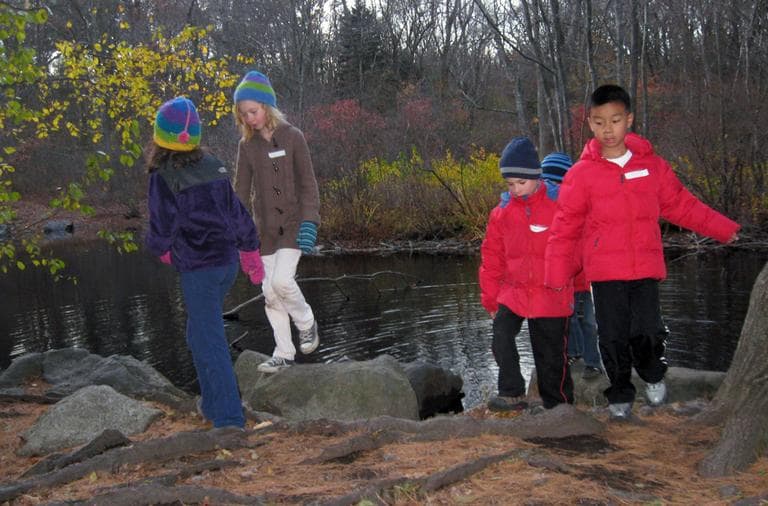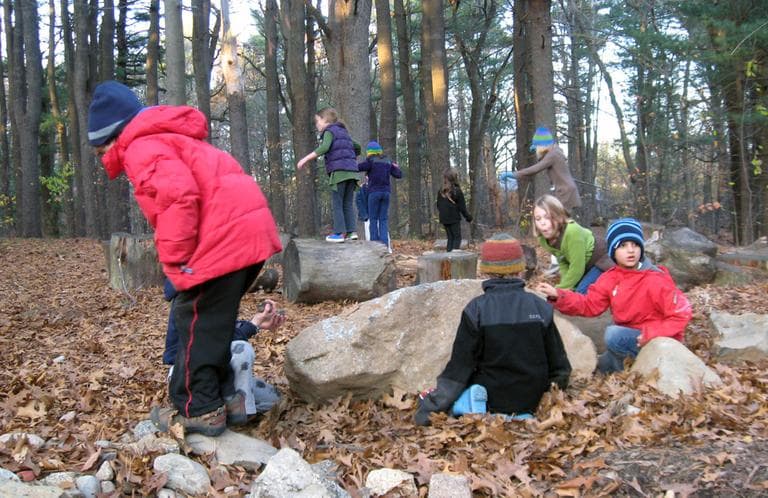Advertisement
Kids Who Don't Get Outside Can Pay To Play
Resume
BELMONT, Mass. — Thanks to huge winter storms, many Massachusetts schoolchildren have already enjoyed a few snow days this winter.
It's hard to imagine any of them spending their entire day off from school inside, but if research is to be believed, a number of them are. Multiple studies in recent years have documented a strong downward trend in the number of hours that school-age children spend outdoors.
All of that research led journalist Richard Louv to write his now-famous book. "Last Child In the Woods," in which he coined the term "nature deficit disorder" — a catch-all phrase for the physical and psychological detriments associated with kids not spending time hanging out outdoors. Disorders like obesity and ADHD are among a litany of conditions that kids who don't get outside often face.
In the five years since Louv's book was published, organizations from the Sierra Club to a number of Boston schools have set up programs to encourage unstructured outdoor play.
It seems like it should be a simple thing: kick the kid out the door and say "go climb a tree," or "go frolic in the snow." But in some places, kids literally pay to play.
Coyote Club
Up on Belmont Hill, the Massachusetts Audubon Society owns 90 acres of well-manicured trails, meadows, ponds and forests. It's where Fran Hutchinson helps run a program called Coyote Club.
Hutchinson's club changes from week to week.
"Well, this is Coyote Club, so we don't really know what we're doing," Hutchinson said. "We have 16 children coming and there really isn't any curriculum, so we'll see what happens with them."
For the last 25 years, Fran has worked on Belmont Hill teaching kids how to identify plant species, spot deer tracks — the usual nature camp sort of thing. But lately, she's noticed a change.
"I just noticed that children really are not that focused on the topic of the class," Hutchinson said. "They're really interested in playing outside. So we decided, why don't we just have a class where they play outside? So we started it last year and it was very popular. And, because of that, this year we now have two groups — one for the younger children who are kindergarten to second grade, and then this one for the third and fourth graders."
"Living in Somerville, which is a highly densely populated city, I just want them to be outside."
Lisa Newton, Coyote Club parent
The groups meet once every month and both of the classes are sold out, at $14 per day, per kid. It's $17 for non-members.
On the day of one of the Coyote Club's meetings, a parade of minivans and SUVs climbs the hill, depositing children who proceed to busy themselves in the woods. A few yards away in the parking lot, parents Lisa Newton and Karen McMann look on.
"Living in Somerville, which is a highly densely populated city, I just want them to be outside," Newton said.
And why can't parents just drive them to a forest and do it for free?
"Well the staff are excellent here," Newton said. "And, this is the forest."
All the little areas of the property have cute names like Pine Knoll and Maple Tree Way, which the kids have learned. Hutchinson and another woman who works at the Audubon Society split the kids into two groups.
Connected by walky-talkies, each pack explored a different destination. I followed a group of kids to Turtle Pond.
Turtle Pond
Once there, the kids just, well ... play. One throws sticks into the water. Another says he's "touching the water to see if anything lives in there, and it climbs and gets out." Most of them don't live near any ponds or streams.

Basically, the Coyote Club is just kids being kids in the way you'd expect, but all under Hutchinson's watchful eye.
"I'm just warning you: if you fall in, I'm not coming in after you," Hutchinson joked to the kids.
The group is unstructured, but it's not unsupervised.
"I think that's why parents feel comfortable with their children coming here, because, you know, we obviously have safety things in check, we have our walky-talkies and first aid kits and everything else," Hutchinson said.
But, I asked Hutchinson, doesn't that take some of the wild out of the wilderness?
"I don't think that this should be their only outdoor experience," Hutchinson said. "But what I'm hoping is that getting some experience, just sort of thinking about things they want to do, will help them when they are in other situations — maybe in their own backyards or other places."
And that seems to be what happens at Coyote Club, to an extent. Unfortunately, I encountered what quantum physicists call "the observer effect," in which the act of observing a phenomenon alters the phenomenon.
Amid the leafs and sticks, the guy with the microphone was the most interesting thing around.
"Will we really have all this on the radio?" one kid asked. "'Cause it is sorta boring."
As darkness fell, the groups found their way back to the parking lot. Minivans and SUVs pulled away and returned the kids to their urban and suburban warrens.
All told, the kids spent about 90 minutes outside. But they'll be back next month.
----
Guest on Radio Boston:
- Phil Primack, writer, editor
More:
- Boston Globe Magazine: The unused playground
This program aired on January 18, 2011.